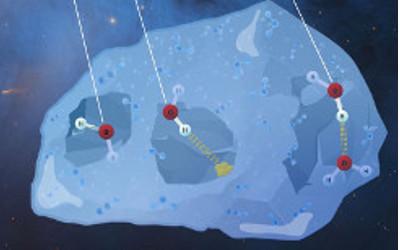OU astronomers make new discoveries about ice structure in space

OU researchers are part of a team who have just published a paper in Nature which describes new findings about the structure of ice in space.
Astronomers, including OU academics, Dr Helen Fraser and Dr Hugh Dickinson and OU PhD student Zak Smith, have discovered the spectral signature of water ice that reveals new information about how ice forms and evolves during the birth of stars and planets. Their findings have been published today in the journal Nature Astronomy
A spectral signature is like the fingerprint of a molecule; it is unique to a particular chemical, and occurs in this case at a specific infrared wavelength that reflects the motion of oxygen and hydrogen atoms in the water molecule, relative to each other.
Astronomers used the James Webb Space Telescope (JWST) to reveal the ‘dangling OH’ features of water ice using observations with the NIRCAM (Near Infrared Camera).
The ‘dangling OH’ signatures reveal water molecules that aren’t fully locked into the ice but are hanging out of the ice surface. This indicates that the material is porous, fluffy and chemically reactive.
This discovery opens a new window on studying star and planet formation since these newly discovered features allow scientists to build up an idea of the spatial distribution and structure of ices, as well as how they evolve on their journey from molecular clouds to planets.
OU scientists from the School of Physical Sciences were instrumental in this discovery as they used local high-performance computing to process the telescope data into spectra and analyzed their findings with data recorded in the OU astrochemical laboratories.
The detection of dangling OH bonds described in the paper, led by Dr Jenny Noble from the French National Centre for Scientific Research (CNRS), are significant because these spectral features have been observed for decades in the laboratory but never before in star-forming regions in space.
The ‘dangling OH’ features lie occur at infrared wavelengths that are impossible to observe with ground-based telescopes but are accessible to JWST. Although it was thought that these features should be observed in the icy material in star-forming regions, this is the first time they have actually been spotted in observations.
Dr Helen Fraser, Senior Lecturer in Astronomy and Director of Research in the School of Physical Sciences, who leads the OU astrochemistry group commented:
“Historically, it was possible to measure intense absorption features linked with major ice species in star-forming clouds, namely water, carbon dioxide, carbon monoxide, methanol, and ammonia. Thanks to JWST’s unprecedented spectral, spatial and flux sensitivity, we can now measure super-weak spectral features, perhaps 1/100th the intensity of the bulk ice bands.”
Researchers used an ice mapping technique developed by Dr Helen Fraser and her team to study ice in a nearby cloud region called Chamaeleon I. This technique allowed them to concurrently analyse light from hundreds of stars behind the cloud, revealing how much ice was present in the molecular cloud. By looking specifical at the ‘dangling OH’ spectral feature, they were able to map the distribution of these surface water molecules and found that they were concentrated around the densest regions encircling a core of gas and dusty material, inside which it is just possible a new star has formed that is only a few thousand years old.
Dr Fraser added;
“I recall when I started my journey in astrochemistry back in 1998, the first paper predicting that dangling OH could be spotted in space was less than 18 months old. Nearly 16 years later, we have finally established that such water molecules are indeed present at the surfaces of icy grains in star-forming regions, and even though they constitute only a tiny fraction (< 0.04 %) of the total number of water molecules in the cloud, its phenomenal we can still “spot” them.”
This discovery opens up an view on the structure of icy material in space, and its potential to catalyze the formation of more complex chemical species as star and planet formation progresses. Research is ongoing in the OU Astrochemistry group to illustrate the power of interstellar ice-mapping.
This story was originally written by Leah Snelus and published on OU News.
You may also be interested in:
Contact our news team
For all out of hours enquiries, please telephone +44 (0)7901 515891
Contact detailsNews & articles

Research image of the month – amplifying voices through visual research
This month’s research image of the month (August 2025) encapsulates Dr Sara Calvo Martinez’s research on how community social enterprises can create inclusive, healing, and empowering spaces for marginalised groups.